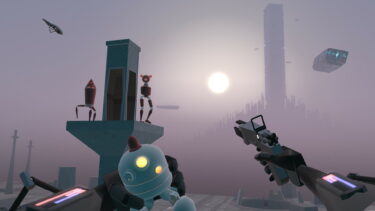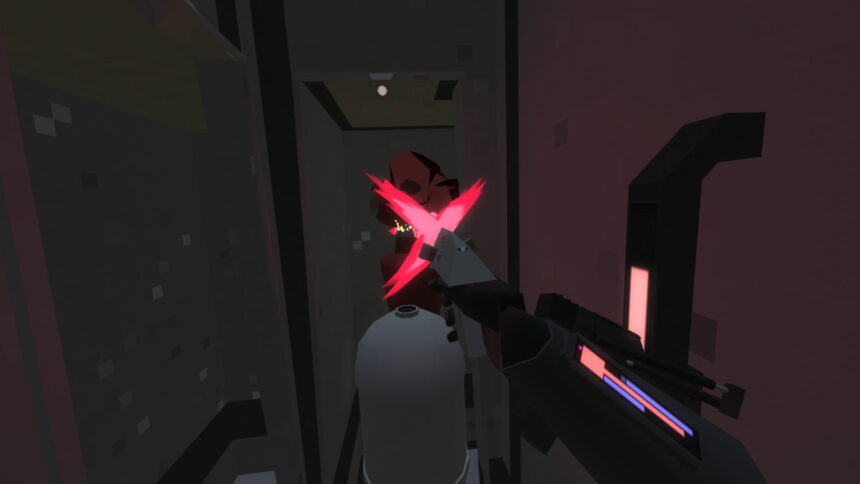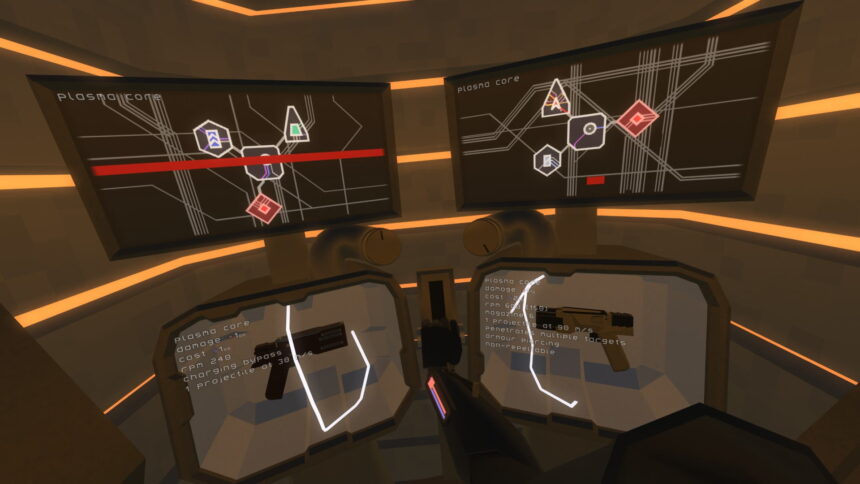Tea For God Review: The world`s most wondrous VR shooter?

Tea For God turns your living room into a giant sci-fi complex. How is this possible? Let's find out in our review for Quest and SteamVR.
Five years ago, Void Room's Tea For God amazed VR enthusiasts. The demo was so clever with its perspective tricks on narrow paths that players felt like they were walking through a huge alien complex with their own legs - without ever using a thumbstick or any other means of locomotion!
In this review, I'll be checking out the full version for Meta Quest, SteamVR, and the Rift Store to see if this trick will hold up for a whole indie game.
Content
Tea For God: Review in a nutshell
Tea For God offers the most surprising locomotion scheme of all VR games! You just have to experience how cleverly this VR game guides players around the corner in real space, while at the same time staging a pleasantly mystical VR shooter!
Tea For God will appeal to you if you ...
- love innovative gameplay and exploration,
- like to delve into strange mechanics and
- like mysterious minimalistic art design.
Tea For God will not appeal to you if you ...
- want a quick and easy way to get started,
- expect a classic, extensive story shooter and
- have an aversion to technically simplistic graphics.
A giant VR maze in your living room
In the age of indie and roguelite shooters, the basic premise of Tea for God should come as no surprise. After the death of your own family, you embark on a mission of vengeance to bring your divine ruler to justice. She is held captive in a surreal and twisted alien complex. The design is reminiscent of horror movies like Cube.
Depending on the mode (action with navigation aids and save points or free exploration through the procedurally generated world), I follow flashing lights or symbols on the cryptic overview map. Along the way, I shoot at attacking robots, upgrade my equipment, and find my way across narrow bridges or elevators. Deciphering small technical puzzles is also on the agenda.
The way the game's creator, Jarosław Ciupiński, sends me through the narrow corridors here amazed me right from the start. Although I only have a playing area of about two by three meters at my disposal, I quickly got the feeling of walking through a huge complex without ever reaching its limits.
The trick with the overlapping corridors is as simple as it is ingenious. Even right next to a long, straight corridor, there can be a second one with many tight turns. As soon as I enter this one, I see nothing of the old straight corridor that was supposed to cross my path.
When I walk around in circles in my real living room, I don't end up back where I started in the game world. Instead, I sometimes find myself on a new, high balcony, where I can engage in gun battles with robots on the opposite tower.
Wireless immersion for Quest and SteamVR
Such uplifting moments in a minimalist setting bring back memories of the multiplayer shooter Tower Tag. The surreal design and spherical music make the world of bizarre tentacled airships seem even more sublime.

The narrow corridors create claustrophobic tension. | Bild: Void Room
Even though I see with my own eyes how the VR game's navigation tricks me, my brain doesn't question the result. After just a few minutes, I find myself dashing down narrow corridors with astonishing confidence, pushing annoying robots into the depths, or bending my knees to squeeze through low ceilings.
It's best to play wirelessly on a PC (SteamVR, Rift) or with the Quest. The lack of wires adds to the sense of freedom! The result turned out to be even more intuitive than in the great Eye of the Temple. There, rolling and moving platforms sometimes left me feeling a bit shaky.
Tea for God rarely gets boring: Even in narrow corridors, I encounter temperamental tin buckets or even cool, multi-limbed boss caterpillars. The arcade-style enemies offer little in the way of clever attack strategies, but most of the gunplay is still entertaining. The environment also invites experimentation. How can you outwit the crackling electric shocks from the ceiling? Is there a way to use the cute robo-spiders that scurry along the walls to your advantage?
Questions like these make exploration exciting, but they can be overwhelming at first. After all, you'll need to familiarize yourself with the various power systems and other alien technology. It's best to use the guided action mode to get your bearings.
Finetune your experience
If you want, you can configure a variety of options to tailor the experience to your own preferences. These include free exploration with no action, precise calibration of the play area in the room, or movement with the thumbstick if desired. The smallest room size accepted by the game is 6 ft x 4 ft (1.80 m x 1.20 m) or 3 ft x 2 feet (90 cm x 60 cm) in horizontal mode.

Some features can be a bit overwhelming at first. | Bild: Void Room
Besides the settings for the haptic vests from bHaptics and Owo, there are also some comfort options, e.g. for the optional vignette. With your own legs as the default locomotion, the game remains almost free of nausea anyway. Small exceptions are fast rides on moving platforms or airships. On the latter, you'll sometimes hack into a turret to target enemies via head movement.
The upgrade stations scattered throughout the levels also add variety. These include niceties like armor-piercing projectiles, shields, recharging health with punches, or merging two energy systems into your own "reactor". Bizarre mushroom-shaped shields or grenades can also be found.
Two additional hip slots provide room for more weapons and gadgets from the environment and enemies. When I'm overrun by enemies at the edge of a conveyor belt, I'll fire targeted electric bolts at nearby sneaky robots. In between, I blow off the heads of distant humanoid robots with another gun, rendering them disoriented and harmless for the time being.
Conclusion: Fascinatingly creative VR shooter design
Tea for God is one of the most fascinating VR concepts I've ever experienced! After just a few minutes, I had internalized the unfamiliar navigation through overlapping rooms so well that I was running through a huge complex full of twisting metal corridors at lightning speed with my own legs. Constant physical movement with my own legs makes the immersion even more convincing than in the great Eye of the Temple with its balancing acts.
My neighbors might get a bizarre picture of me running around the living room like a neurotic predator in a zoo. But in the game world, the illusion is perfect, allowing for a small but unique VR shooter in a pleasantly surreal setting. Due to the minimalist design, there are hardly any graphical differences between the versions.
Tea for God is available for SteamVR, Rift and Quest, priced at around $20. The Quest version also supports Quest 1. Make sure you get the full game on the App Lab Store. Alternatively, there are also earlier free (demo) versions in the mentioned stores and on itch.io.
Note: Links to online stores in articles can be so-called affiliate links. If you buy through this link, MIXED receives a commission from the provider. For you the price does not change.